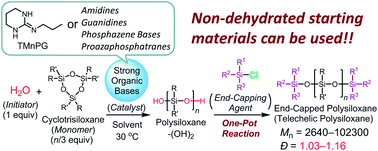当前位置:
X-MOL 学术
›
Chem. Sci.
›
论文详情
Our official English website, www.x-mol.net, welcomes your feedback! (Note: you will need to create a separate account there.)
Organocatalytic controlled/living ring-opening polymerization of cyclotrisiloxanes initiated by water with strong organic base catalysts†
Chemical Science ( IF 8.4 ) Pub Date : 2018-02-19 00:00:00 , DOI: 10.1039/c7sc04234e Keita Fuchise 1 , Masayasu Igarashi 1 , Kazuhiko Sato 1 , Shigeru Shimada 1
Chemical Science ( IF 8.4 ) Pub Date : 2018-02-19 00:00:00 , DOI: 10.1039/c7sc04234e Keita Fuchise 1 , Masayasu Igarashi 1 , Kazuhiko Sato 1 , Shigeru Shimada 1
Affiliation

|
Organocatalytic controlled/living ring-opening polymerization of cyclotrisiloxanes, such as hexamethylcyclotrisiloxane, 1,3,5-trimethyl-1,3,5-triphenylcyclotrisiloxane, 1,3,5-trimethyl-1,3,5-trivinylcyclotrisiloxane, and 1,3,5-trimethyl-1,3,5-tris(3,3,3-trifluoropropyl)cyclotrisiloxane, using water as an initiator and strong organic bases, such as amidines, guanidines, phosphazene bases, and proazaphosphatrane, as catalysts produced a variety of polysiloxanes with controlled number-average molecular weights (Mn = 2.64–102.3 kg mol−1), narrow polydispersity (Đ = 1.03–1.16), and well-defined symmetric structures. Controlled syntheses of statistical copolymers and triblock copolymers were achieved by copolymerizations of two cyclotrisiloxanes. Various terminal functionalities were successfully introduced by the end-capping reaction of propagating polysiloxanes using functional chlorosilanes. Kinetic investigations demonstrated that the polymerization proceeded through the initiator/chain-end activation mechanism, namely activations of water in the initiation reaction and of terminal silanols in propagating polysiloxanes in the propagation reaction. Catalytic activities of strong organic bases were revealed to depend on their Brønsted basicity and efficiency of the proton transfer in the initiation and propagation reactions. Guanidines possessing an R–N![[double bond, length as m-dash]](https://www.rsc.org/images/entities/char_e001.gif) C(N)–NH–R′ unit, in particular 1,3-trimethylene-2-propylguanidine, showed excellent performance as a catalyst. In this system, even non-dehydrated solvents are usable for the polymerization.
C(N)–NH–R′ unit, in particular 1,3-trimethylene-2-propylguanidine, showed excellent performance as a catalyst. In this system, even non-dehydrated solvents are usable for the polymerization.
中文翻译:

由水与强有机碱催化剂引发的环三硅氧烷的有机催化可控/活性开环聚合†
环三硅氧烷,例如六甲基环三硅氧烷、1,3,5-三甲基-1,3,5-三苯基环三硅氧烷、1,3,5-三甲基-1,3,5-三乙烯基环三硅氧烷和1, 3,5-trimethyl-1,3,5-tris(3,3,3-trifluoropropyl)cyclotrisiloxane,使用水作为引发剂和强有机碱,如脒、胍、磷腈碱和 proazaphosphatrane,作为催化剂产生了具有可控数均分子量 ( M n = 2.64–102.3 kg mol -1 )、窄多分散性 ( Đ= 1.03–1.16),以及定义明确的对称结构。统计共聚物和三嵌段共聚物的受控合成是通过两种环三硅氧烷的共聚来实现的。通过使用功能性氯硅烷的增殖聚硅氧烷的封端反应成功地引入了各种末端官能团。动力学研究表明,聚合是通过引发剂/链末端活化机制进行的,即引发反应中水的活化和增长反应中聚硅氧烷增长中的末端硅烷醇的活化。强有机碱的催化活性取决于它们的布朗斯台德碱度和引发和增长反应中质子转移的效率。具有 R-N 的胍![[双键,长度为 m-dash]](https://www.rsc.org/images/entities/char_e001.gif) C(N)-NH-R'单元,特别是1,3-三亚甲基-2-丙基胍,作为催化剂表现出优异的性能。在该体系中,甚至未脱水的溶剂也可用于聚合。
C(N)-NH-R'单元,特别是1,3-三亚甲基-2-丙基胍,作为催化剂表现出优异的性能。在该体系中,甚至未脱水的溶剂也可用于聚合。
更新日期:2018-02-19
![[double bond, length as m-dash]](https://www.rsc.org/images/entities/char_e001.gif) C(N)–NH–R′ unit, in particular 1,3-trimethylene-2-propylguanidine, showed excellent performance as a catalyst. In this system, even non-dehydrated solvents are usable for the polymerization.
C(N)–NH–R′ unit, in particular 1,3-trimethylene-2-propylguanidine, showed excellent performance as a catalyst. In this system, even non-dehydrated solvents are usable for the polymerization.
中文翻译:

由水与强有机碱催化剂引发的环三硅氧烷的有机催化可控/活性开环聚合†
环三硅氧烷,例如六甲基环三硅氧烷、1,3,5-三甲基-1,3,5-三苯基环三硅氧烷、1,3,5-三甲基-1,3,5-三乙烯基环三硅氧烷和1, 3,5-trimethyl-1,3,5-tris(3,3,3-trifluoropropyl)cyclotrisiloxane,使用水作为引发剂和强有机碱,如脒、胍、磷腈碱和 proazaphosphatrane,作为催化剂产生了具有可控数均分子量 ( M n = 2.64–102.3 kg mol -1 )、窄多分散性 ( Đ= 1.03–1.16),以及定义明确的对称结构。统计共聚物和三嵌段共聚物的受控合成是通过两种环三硅氧烷的共聚来实现的。通过使用功能性氯硅烷的增殖聚硅氧烷的封端反应成功地引入了各种末端官能团。动力学研究表明,聚合是通过引发剂/链末端活化机制进行的,即引发反应中水的活化和增长反应中聚硅氧烷增长中的末端硅烷醇的活化。强有机碱的催化活性取决于它们的布朗斯台德碱度和引发和增长反应中质子转移的效率。具有 R-N 的胍
![[双键,长度为 m-dash]](https://www.rsc.org/images/entities/char_e001.gif) C(N)-NH-R'单元,特别是1,3-三亚甲基-2-丙基胍,作为催化剂表现出优异的性能。在该体系中,甚至未脱水的溶剂也可用于聚合。
C(N)-NH-R'单元,特别是1,3-三亚甲基-2-丙基胍,作为催化剂表现出优异的性能。在该体系中,甚至未脱水的溶剂也可用于聚合。



























 京公网安备 11010802027423号
京公网安备 11010802027423号